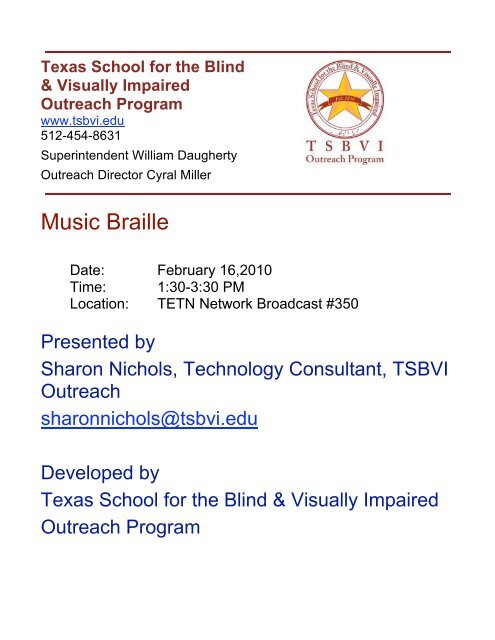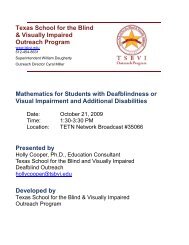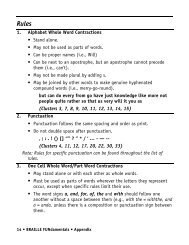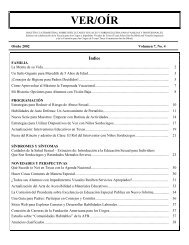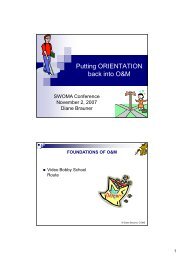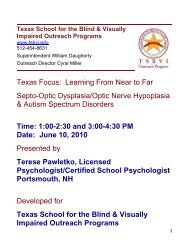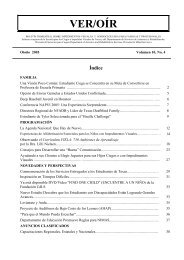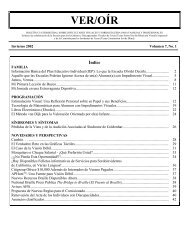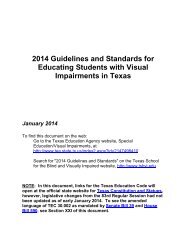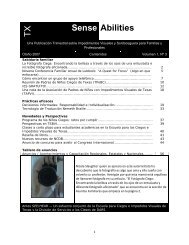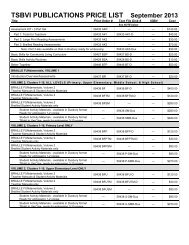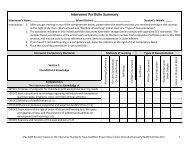Music Braille - Texas School for the Blind and Visually Impaired
Music Braille - Texas School for the Blind and Visually Impaired
Music Braille - Texas School for the Blind and Visually Impaired
Create successful ePaper yourself
Turn your PDF publications into a flip-book with our unique Google optimized e-Paper software.
<strong>Texas</strong> <strong>School</strong> <strong>for</strong> <strong>the</strong> <strong>Blind</strong>& <strong>Visually</strong> <strong>Impaired</strong>Outreach Programwww.tsbvi.edu512-454-8631Superintendent William DaughertyOutreach Director Cyral Miller<strong>Music</strong> <strong>Braille</strong>Date: February 16,2010Time: 1:30-3:30 PMLocation: TETN Network Broadcast #350Presented bySharon Nichols, Technology Consultant, TSBVIOutreachsharonnichols@tsbvi.eduDeveloped by<strong>Texas</strong> <strong>School</strong> <strong>for</strong> <strong>the</strong> <strong>Blind</strong> & <strong>Visually</strong> <strong>Impaired</strong>Outreach Program
TSBVI Outreach TETN # 35062 – <strong>Braille</strong> <strong>Music</strong> – Nichols, 2010 1
TOPICS TO COVER Why <strong>Music</strong> <strong>Braille</strong> Teaching <strong>Music</strong> <strong>Braille</strong> <strong>Music</strong> <strong>Braille</strong> Resources Creating <strong>Music</strong> <strong>Braille</strong> Working with <strong>Music</strong> Teachers Student Creation of <strong>Music</strong> <strong>Braille</strong>WHY MUSIC BRAILLE Article NFB Video Measure <strong>for</strong> Measure: Achieving Equality through<strong>Braille</strong> <strong>Music</strong> Literacyhttp://www.youtube.com/watch?v=P8Ti1dlrud4TEACHING MUSIC BRAILLE <strong>Music</strong> Teacher or TVI How WhenMUSIC BRAILLE RESOURCES Classes RNIB Course Books Networking <strong>Braille</strong> Through Remote Learning: <strong>Music</strong> <strong>Braille</strong> Overviewhttp://www.brl.org/codes/session09/overview.html Royal National Institute of <strong>Blind</strong> People: <strong>Music</strong> books <strong>and</strong> brailletranscriptionhttp://www.rnib.org.uk/livingwithsightloss/leisureculture/music/readingmusic/Pages/musicbooks.aspx#H2Heading5TSBVI Outreach TETN # 35062 – <strong>Braille</strong> <strong>Music</strong> – Nichols, 2010 2
CREATING MUSIC BRAILLE Braillist TVI <strong>Music</strong> Teacher B<strong>and</strong> Director or Staff Dancing Dot's Goodfeel:http://www.dancingdots.com/main/goodfeel.htm Finale software: http://www.finalemusic.com/Finale/STUDENT CREATION OF MUSIC Lime Aloud with JAWS Print or <strong>Braille</strong> <strong>Braille</strong> Display PC Keyboard MIDI Keyboard Lime Aloud: A Whole New Way <strong>for</strong> <strong>the</strong> <strong>Blind</strong> to Read <strong>and</strong> Write<strong>Music</strong> www.dancingdots.com/prodesc/limealoud.htmTSBVI Outreach TETN # 35062 – <strong>Braille</strong> <strong>Music</strong> – Nichols, 2010 3
WHY BRAILLE MUSIC?"For those who don't know, <strong>the</strong> stupidity of braille music is that aliterary D equals a music C, a literary E is a music D <strong>and</strong> so<strong>for</strong>th."It is important to remember that Louis <strong>Braille</strong>, a brilliant teenager from asmall town near Paris, spent his teenage years perfecting a unifiedsystem using a six-dot cell to faithfully represent literary, ma<strong>the</strong>matical<strong>and</strong> musical in<strong>for</strong>mation. At <strong>the</strong> age of twenty, he published his codewhich is essentially <strong>the</strong> same today as it was in 1829.I would love to have <strong>the</strong> chance to ask him why he chose dots 1-4-5 torepresent <strong>the</strong> pitch we call C. I suspect that his choices <strong>for</strong> dot patternshad more to do with geometry than any correspondence to literarybraille. But one thing is <strong>for</strong> certain, he himself did not call that pitch C.He called it what people in France <strong>and</strong> many non-English-speakingcountries still call it today, that is, DO (pronounced doe).So, we can speculate that he may have been thinking D <strong>for</strong> "doe". Onething is <strong>for</strong> certain: he *was* thinking! Today, <strong>Braille</strong> is buried in <strong>the</strong>Pan<strong>the</strong>on of Heroes in Paris because he made blind people literateusing a system so well suited to <strong>the</strong> way <strong>the</strong>y perceive <strong>the</strong> world.Many credit him <strong>for</strong> designing <strong>the</strong> world's first dot matrix printer, adevice <strong>for</strong> embossing patterns of dots to <strong>for</strong>m print characters, which hecalled raphigraphy.During his lifetime he was praised <strong>for</strong> his musicianship as an organist<strong>and</strong> cellist by many, including Felix Mendelssohn. Be<strong>for</strong>e his prematuredeath at <strong>the</strong> age of 43 he was nominated <strong>for</strong> one of France's highestnational Medals of Honor but never received <strong>the</strong> acclaim he deserved inhis own day. At a time when <strong>the</strong> career choices of <strong>the</strong> vast majority ofblind people were to work as professional beggars or worse, he led adistinguished career as a teacher, per<strong>for</strong>ming musician <strong>and</strong> inventor. Inhis will he left significant sums to his family, friends, school <strong>and</strong> church.TSBVI Outreach TETN # 35062 – <strong>Braille</strong> <strong>Music</strong> – Nichols, 2010 4
But, back to his system! The seven degrees of <strong>the</strong> western scale arerepresented in <strong>Braille</strong>'s system by seven combinations of <strong>the</strong> top 4 dotsin <strong>the</strong> six-dot braille cell. The bottom two dots indicate <strong>the</strong> rhythm <strong>for</strong>that pitch. So, beneath <strong>the</strong> tip of one finger, we can read <strong>the</strong> two mostimportant attributes of a note. The braille music code is well defined<strong>and</strong> capable of faithfully representing extremely complex pieces ofmusic. In some ways, it is more logical than staff notation.In <strong>the</strong> venerable solfege system, <strong>the</strong> seven degrees of <strong>the</strong> scale arecalled (I will spell phonetically so screen reader software will pronounceproperly) doe, ray, me, fa, sol, la, <strong>and</strong> ti. The sequence representing<strong>the</strong> corresponding braille characters <strong>for</strong> <strong>the</strong>se pitches is <strong>the</strong> same as <strong>the</strong>letters d through j in <strong>the</strong> literary braille code. When I teach music brailleto a beginner, though, I insist that <strong>the</strong>y refer to <strong>the</strong> solfege names <strong>for</strong><strong>the</strong> scale degrees to prevent code confusion between music braille <strong>and</strong>literary braille until <strong>the</strong>y are completely com<strong>for</strong>table with <strong>the</strong> codeswitching required by <strong>the</strong> brain as one reads <strong>the</strong> braille. So, if <strong>the</strong>student reads dots 1-4-5, he must read it as "doe". If dots 2-4, it mustbe called LA. 2-4-5 is called TI <strong>and</strong> certainly not J. Again, <strong>the</strong> mostimportant thing to remember when we read music braille code or mathcode or any braille code that's not literary code, is that it is indeed notliterary material but ra<strong>the</strong>r a total redefinition of those 64 uniquepatterns we can make from <strong>the</strong> six-dot cell.With practice, blind musicians can sing melodies "at sight" <strong>and</strong>participate fully in classes on sight singing. If a student is proficient inreading literary braille <strong>the</strong>re is no reason why he or she cannot learn toread music braille. A braille score provides not only <strong>the</strong> pitches <strong>and</strong>rhythms to be per<strong>for</strong>med but also all of <strong>the</strong> dynamic marks, articulations<strong>and</strong> directions from <strong>the</strong> composer.Un<strong>for</strong>tunately, most of <strong>the</strong> people who tried to teach us to read music inbraille really had no idea just how to teach us. Sadly, many of <strong>the</strong>m didso half-heartedly with <strong>the</strong> preconceived notion that we would neverlearn it. Many of us learned to repeat <strong>the</strong>ir unin<strong>for</strong>med position thatbraille music is just too hard <strong>for</strong> us to learn. Through his courses <strong>and</strong>numerous articles <strong>and</strong> presentations, Richard Taesch has been aTSBVI Outreach TETN # 35062 – <strong>Braille</strong> <strong>Music</strong> – Nichols, 2010 5
positive <strong>for</strong>ce in our time in changing attitudes about braille music. Istarted Dancing Dots to find ways to increase <strong>the</strong> amount <strong>and</strong> variety ofbraille music <strong>and</strong> thus encourage more people to use it. I like to thinkthat our work carries on <strong>the</strong> spirit of Mr. <strong>Braille</strong> <strong>and</strong> his quest <strong>for</strong> literacy,inclusion <strong>and</strong> independence <strong>for</strong> blind people.I say: Long live braille! I do believe strongly that, especially in aneducational situation, blind musicians who can read literary braille oughtto learn to read music braille. In a school where sighted students areexpected to read music to satisfy course requirements, <strong>the</strong> presumptionshould be that a student who reads literary braille can <strong>and</strong> should learnto read <strong>and</strong> write music in braille. And now, with our access solutions tonotation programs such as Sibelius <strong>and</strong> Lime, blind people can alsolearn to print <strong>the</strong>ir musical ideas <strong>for</strong> sighted per<strong>for</strong>mers, teachers,students <strong>and</strong> colleagues.An admirer of M. <strong>Braille</strong> <strong>and</strong> his brilliant system,Bill McCannFounder <strong>and</strong> President of Dancing Dots since 1992TSBVI Outreach TETN # 35062 – <strong>Braille</strong> <strong>Music</strong> – Nichols, 2010 6
MUSIC BRAILLE<strong>Music</strong> <strong>Braille</strong> I: OverviewWelcome to music braille! <strong>Music</strong> braille represents a challenge beyondeven o<strong>the</strong>r specialized codes such as ma<strong>the</strong>matics! The complexity ofmost print music requires significant skills on <strong>the</strong> part of <strong>the</strong> transcriber,<strong>the</strong> most important being <strong>the</strong> willingness <strong>and</strong> ability to think through <strong>the</strong>transcription be<strong>for</strong>e sitting down at <strong>the</strong> brailler or computer.There are some who will argue that <strong>the</strong> braillist need not be able to readprint music, but, like ma<strong>the</strong>matics braille, <strong>the</strong> music braillist who hassome abilities in music is clearly at an advantage. Be<strong>for</strong>e getting intospecifics, this reading works to point out some key generalizationsabout braille music:1. Unlike print music, braille music is not written on a staff.2. There are three "styles", or methods, of <strong>for</strong>matting braille music:o bar-over-baro line-by-lineo single lineEach of <strong>the</strong>se methods will be explained in detail in <strong>the</strong>appropriate sessions.3. Clef signs are generally omitted in braille, replacedby octave marks.4. There is specific <strong>for</strong>matting/layout rules <strong>for</strong> vocal, strings,percussion, winds, etc. that <strong>the</strong> braille music transcriber mustlearn.5. Bar lines between measures are indicated with a space.ResourcesThere are a number of resources available, in addition to <strong>the</strong>se lessons,to help you with your learning of braille music. In an order of most useful(at least to me!), <strong>the</strong>se resources are: How to Read <strong>Braille</strong> <strong>Music</strong>: An Introduction, by Bettye Krolick,available at Opus Technologies Primer of <strong>Braille</strong> <strong>Music</strong>, Edward Jenkins, American Printing HouseTSBVI Outreach TETN # 35062 – <strong>Braille</strong> <strong>Music</strong> – Nichols, 2010 7
<strong>for</strong> <strong>the</strong> <strong>Blind</strong> An Introduction to <strong>Braille</strong> <strong>Music</strong>, Edward Godfrey, National <strong>Braille</strong>Association H<strong>and</strong>book <strong>for</strong> <strong>Braille</strong> <strong>Music</strong> Transcribers, National <strong>Braille</strong>AssociationIn addition, <strong>the</strong> New International Manual of <strong>Braille</strong> <strong>Music</strong> Notation,published by <strong>the</strong> <strong>Braille</strong> <strong>Music</strong> Subcommittee, World <strong>Blind</strong> Union iscurrently being prepared <strong>for</strong> publication on <strong>the</strong> Web through this site.As with <strong>the</strong> textbook code, <strong>the</strong> <strong>Braille</strong> Authority of North American(BANA) has recently (Fall 1998) approved changes in <strong>the</strong> braille musiccode. Most of <strong>the</strong> code is unchanged, but <strong>the</strong>re are some changes.Several examples are listed below, <strong>and</strong> <strong>the</strong>y will be re-stated in <strong>the</strong>appropriate sessions:1. No contractions should be used in music title pages2. Texts of songs, excepting songs <strong>and</strong> chants in hymnals <strong>and</strong> schoolmaterials <strong>for</strong> grades K-6, should be in grade 1 braille. When songtexts are in grade 1 braille, all directions <strong>and</strong> indications of tempo<strong>and</strong> mood, <strong>and</strong> all transcriber notes should also be uncontracted.3. Words that in braille are placed above <strong>the</strong> music line are to beenclosed between word signs. Paren<strong>the</strong>ses that are not included inprint must not be added in braille.4. All transcriber-added signs such as "understood" rests <strong>and</strong>accidentals must be preceded by a Dot 5. This practice has beenoptional in <strong>the</strong> past, but is now m<strong>and</strong>atory.<strong>Music</strong> <strong>Braille</strong>: Notes <strong>and</strong> RestsThere are seven notes in a musical scale, typically beginning with <strong>the</strong>note "C", followed by: D E F G A B. These notes are also sometimesdesignated "do re mi la so la ti", but you will probably not encounter thatnotation. The braille equivalents of <strong>the</strong> seven basic notes must bememorized, using <strong>the</strong>se guidelines to help:1. Eighth notes have no dots 3 or 62. Quarter notes have a dot 6TSBVI Outreach TETN # 35062 – <strong>Braille</strong> <strong>Music</strong> – Nichols, 2010 8
3. Half notes have a dot 3 but no dot 64. Whole notes have both dots 3 <strong>and</strong> 6For example, <strong>the</strong> scales <strong>for</strong> quarter notes <strong>and</strong> whole notes are shownbelow, followed by a table of all of <strong>the</strong> notes:[Note: <strong>the</strong> example above is slightly incorrect, in that octave marks areneeded, but are not used as <strong>the</strong>y have not been presented to <strong>the</strong>student yet!]Type C D E F G A B RestWholes or 16thsHalves or 32ndsQuarters or 64ths8ths or 128thsSome notes are also "dotted", meaning <strong>the</strong>y have an extra time value.TSBVI Outreach TETN # 35062 – <strong>Braille</strong> <strong>Music</strong> – Nichols, 2010 9
The dotted braille notation is a dot 3 .A simple example should help:For smaller notes <strong>and</strong> rests, such as 128ths, <strong>the</strong> braillist should use thischart. Basically, you use <strong>the</strong> same symbols as <strong>for</strong> eighth, quarter, half,<strong>and</strong> whole notes:Regular valueEighth note (1/8)Smaller value <strong>Braille</strong>128th noteQuarter note (1/4) 64th noteHalf note (1/2)Whole note32nd note16th noteOctave MarksNow comes <strong>the</strong> really tricky part of writing notes! Notes come in octaves,units of seven notes. You can have <strong>the</strong> same note name but in severaldifferent octaves. For example, <strong>the</strong> note "C" can be found in manydifferent octaves. We need some way in braille to represent <strong>the</strong> samenote as seen in <strong>the</strong> various octaves. Octave marks serve that purpose.TSBVI Outreach TETN # 35062 – <strong>Braille</strong> <strong>Music</strong> – Nichols, 2010 10
1st (bass)2nd (bass)3rd (bass)4th (treble)5th (treble)6th (treble)7 thThere are, as you might suspect, a list of rules <strong>for</strong> <strong>the</strong> use of octavemarks:1. an octave mark is always required be<strong>for</strong>e <strong>the</strong> first note in a line ofmusic2. When <strong>the</strong> interval between two notes is a second or a third, noTSBVI Outreach TETN # 35062 – <strong>Braille</strong> <strong>Music</strong> – Nichols, 2010 11
octave mark is required. To figure out an interval, count <strong>the</strong> spaces<strong>and</strong> lines between two notes, making sure to include <strong>the</strong> notes<strong>the</strong>mselves. For example:IntervalnameSecondThirdFourthFifthIntervalDescriptionStarting on middle C, <strong>the</strong> interval goes up onewhole step to a D. Counting both <strong>the</strong> C <strong>and</strong><strong>the</strong> D, <strong>the</strong> interval is a secondStarting on middle C, count <strong>the</strong> C, <strong>the</strong> spaceafter <strong>the</strong> C, <strong>and</strong> <strong>the</strong> E note on <strong>the</strong> first line.This interval is a third.Starting on middle C, <strong>the</strong> interval goes up toan F, <strong>the</strong> first space on <strong>the</strong> staff. C-d-e-Fgives you an interval of a fourth. The lowercase notes in <strong>the</strong> previous sentence indicateskipped notes.C-d-e-f-G, a fifthSixthC-d-e-f-g-A, a sixth3. When <strong>the</strong> interval is a fourth or a fifth, an octave mark is requiredonly when <strong>the</strong> second note is in a different octave.4. When <strong>the</strong> interval is a sixth or greater, <strong>the</strong> octave mark is alwaysused.An example is certainly useful at this point!TSBVI Outreach TETN # 35062 – <strong>Braille</strong> <strong>Music</strong> – Nichols, 2010 12
A measure-by-measure analysis:1. This measure starts with an octave 4 mark (dot 5), since it is <strong>the</strong>first measure2. no octave mark3. this measure starts with an octave 4 mark, since <strong>the</strong> last note in<strong>the</strong> previous measure (<strong>the</strong> C) is a fifth away from <strong>the</strong> first note inMeasure 3 (an F). The "fifth" rule says to use an octave markwhen <strong>the</strong> second note is in a different octave. The C is in <strong>the</strong>fifth octave, <strong>and</strong> <strong>the</strong> F is in <strong>the</strong> fourth. Why didn't we use <strong>the</strong>octave 5 marker <strong>for</strong> <strong>the</strong> C? Because it only had an interval of asecond (B --> C) from <strong>the</strong> previous note.4. no octave mark here, still in Octave 45. no octave mark here, still in Octave 46. This measures starts with an octave 5 mark, since <strong>the</strong> C is afourth from <strong>the</strong> preceding G. We do not need an octave markbe<strong>for</strong>e <strong>the</strong> A, since its interval is a third7. no octave marks here8. no octave marks here9. no octave marks here10. no octave marks hereTSBVI Outreach TETN # 35062 – <strong>Braille</strong> <strong>Music</strong> – Nichols, 2010 13
11. Measure 11 uses an octave 5 marker, since <strong>the</strong> interval from <strong>the</strong>F to <strong>the</strong> D is a sixth.12. no octave marks here13. The interval skip of a fifth from <strong>the</strong> A to <strong>the</strong> E, spanning Octaves4 <strong>and</strong> 5, requires <strong>the</strong> use of <strong>the</strong> octave 5 marker.14. no octave marks here15. no octave marks here16. no octave marks hereTime SignaturesTime signatures in music represent a way of expressing <strong>the</strong> number ofbeats in a measure <strong>and</strong> how much each beat is worth. For example, a"4/4" time signature means that <strong>the</strong>re are four beats in a measure, <strong>and</strong>each beat has a value of a quarter note. A time signature of "12/8"means <strong>the</strong>re are 12 beats in a measure, <strong>and</strong> each beat has <strong>the</strong> value ofan eighth note.Time signatures are very straight-<strong>for</strong>ward. The table below shows someexamples:Symbol <strong>Braille</strong> notationTSBVI Outreach TETN # 35062 – <strong>Braille</strong> <strong>Music</strong> – Nichols, 2010 14
If you are new to music, <strong>the</strong> "C" with <strong>the</strong> bar is called "cut time", <strong>and</strong>basically is equivalent to 2/2 time. The "C" is known as common time,<strong>and</strong> is equivalent to 4/4 time.Time signatures are normally centered above <strong>the</strong> first line of music orwords, in combination with <strong>the</strong> key signature. Often in music <strong>the</strong>re is achange in time signature -- this is represented in braille where itappears, with a space preceding <strong>and</strong> following <strong>the</strong> time signature.Key signaturesKey signatures in music represent <strong>the</strong> number of sharps <strong>and</strong> flats thatare "common" throughout a piece of music. For example, a piece ofmusic written in G major will have one sharp (an F sharp). The musicianassumes that any F he or she encounters is sharp, unless <strong>the</strong> musicspecifically says o<strong>the</strong>rwise!Key signatures, like time signatures, are also easy:TSBVI Outreach TETN # 35062 – <strong>Braille</strong> <strong>Music</strong> – Nichols, 2010 15
In <strong>the</strong> first example, to combine <strong>the</strong> key signature with <strong>the</strong> timesignature, <strong>the</strong> braille would be:Again, this in<strong>for</strong>mation is normally centered above <strong>the</strong> first line of music.AccidentalsAccidentals in music are <strong>the</strong> sharps, flats, <strong>and</strong> naturals that are placedin front of a single note to change its pitch. If you recall from <strong>the</strong>previous reading on key signatures, each piece of music is written witha "generic" set of notes that are sharped or made flat. For example, in<strong>the</strong> key of G, <strong>the</strong> F is always sharp, unless an accidental changes it.You should recall <strong>the</strong> braille notation of sharps, flats, <strong>and</strong> naturals from<strong>the</strong> reading on key signatures:Sharp:Flat:Natural:A simple scale shows how to use this notation:TSBVI Outreach TETN # 35062 – <strong>Braille</strong> <strong>Music</strong> – Nichols, 2010 16
Expression MarkingsDynamic markings are <strong>the</strong> print notations that tell <strong>the</strong> musician how loudor soft to per<strong>for</strong>m <strong>the</strong> music. Dynamic markings in music can ei<strong>the</strong>r bewords or abbreviations of words, or symbolic. Expression markings arethose special symbols that describe o<strong>the</strong>r modifications, such as anincrease in tempo. Expression markings in this session refer to all printnotations that describe to <strong>the</strong> musician how to per<strong>for</strong>m <strong>the</strong> music,including volume, tempo, etc.One of <strong>the</strong> most important signs here is <strong>the</strong> "word sign", . In braillemusic, literary material is always preceded by <strong>the</strong> word sign. Dynamics<strong>and</strong> abbreviations are preceded by this word sign, <strong>and</strong> placed withoutany intervening spaces.Name ofdynamicCrescendo or cresc.Decrescendo (diminuendo)Cresc. (abbreviatedcrescendoDecresc. (abbreviateddecrescendoSwell(cresc/decresc. on a singlenoteDiminuendoForteCommonsymbolcresc.decresc.dim.f⣃⣗⣁⣊⣇⣇⣑⣝⣕⣞⣁⣞⣊⣕⣝⣨⣨⣨⣨⣨⣨TSBVI Outreach TETN # 35062 – <strong>Braille</strong> <strong>Music</strong> – Nichols, 2010 17
FortissimoFortississimoMezzo-<strong>for</strong>teMezzo-pianoPianoPianissimoAcceler<strong>and</strong>oRallent<strong>and</strong>oRitard<strong>and</strong>oRitenutofffffmfmppppaccel.rallen.rit.riten.Pause(fermata)Tenuto(pressed tone)Comma(break in rhythm)'Staccato(detached note)Staccatissimo(very detached note)Some notes on usage of expression marks. The expression mark goesTSBVI Outreach TETN # 35062 – <strong>Braille</strong> <strong>Music</strong> – Nichols, 2010 18
in front of <strong>the</strong> note it is affecting. In <strong>the</strong> case of "multiple-note"expressions (such as <strong>the</strong> graphic crescendo <strong>and</strong> decrescendo), <strong>the</strong>beginning <strong>the</strong> expression goes in front of <strong>the</strong> first note affected, <strong>and</strong>terminates after <strong>the</strong> last note affected. The multiple expression can alsobe cancelled by ano<strong>the</strong>r expression marking, such as in this example:In this example, <strong>the</strong> crescendo that starts on <strong>the</strong> B in <strong>the</strong> first measureis terminated by <strong>the</strong> <strong>for</strong>tissimo expression mark on <strong>the</strong> E in <strong>the</strong> secondmeasure.The note following an expression mark must have a new octave mark. If<strong>the</strong> braille cell following <strong>the</strong> expression mark contains dots 1, 2, <strong>and</strong>/or3, <strong>the</strong>re must be a dot 3 following <strong>the</strong> expression mark. An example:In this example, <strong>the</strong> expression mark <strong>for</strong> <strong>the</strong> <strong>for</strong>tissimo is "closed" with adot 3, since <strong>the</strong> next cell contains <strong>the</strong> dots 2-3-6 notation <strong>for</strong> a staccatonote. Since that notation has left-dots (2 <strong>and</strong> 3), <strong>the</strong> expression markmust be closed off with <strong>the</strong> dot 3. In this example, we also takeadvantage of doubling -- since we have four staccato notes, we canput a double staccato symbol in front of <strong>the</strong> first staccato note, <strong>and</strong> <strong>the</strong>na single staccato symbol in front of <strong>the</strong> last staccato note. Doubling canbe used if you have four consecutive notes that contain <strong>the</strong> samenotation. Doubling is not interrupted if you have rests between <strong>the</strong>affected notes.In this example, we could actually do <strong>the</strong> braille much more simply.TSBVI Outreach TETN # 35062 – <strong>Braille</strong> <strong>Music</strong> – Nichols, 2010 19
Since <strong>the</strong>re are four notes that have staccato marks, we can use <strong>the</strong>"double" staccato mark. Put a double staccato mark (dots 2-3-6) where<strong>the</strong> consecutive notes begin, <strong>and</strong> one be<strong>for</strong>e <strong>the</strong> last staccato'd note. If<strong>the</strong>re are rests between consecutive notes, you can still use <strong>the</strong>doubling notation.Words of ExpressionIn addition to some of <strong>the</strong> expression markings shown above, printmusic routinely includes notations such as "a tempo", "allegro","moderato", <strong>and</strong> <strong>the</strong> like. These often indicate tempo <strong>and</strong> mood. When<strong>the</strong>se words are printed above <strong>the</strong> music at <strong>the</strong> beginning of <strong>the</strong> piece,<strong>the</strong>y are transcribed on <strong>the</strong> same line as <strong>the</strong> key <strong>and</strong> time signatures,preceding <strong>the</strong>m <strong>and</strong> centered. For example, a piece with four sharps in3/4 time with <strong>the</strong> words "Con moto" would appear as such:No contractions are used <strong>for</strong> <strong>for</strong>eign words, but can be used <strong>for</strong> wordssuch as "Moderately fast" or "quickly."More difficult are metronome markings. These indicate how quickly aparticular note value is to be played. For example, <strong>the</strong> sample belowsuggests that this music is to be played reasonably fast, 120 quarternotes per minute!Often times <strong>the</strong>re will be a variety of markings at <strong>the</strong> beginning of <strong>the</strong>piece. Tempo markings are usually brailled first, <strong>the</strong>n dynamicmarkings. Follow, however, <strong>the</strong> print notation, brailling things thatTSBVI Outreach TETN # 35062 – <strong>Braille</strong> <strong>Music</strong> – Nichols, 2010 20
appear first (far<strong>the</strong>st to <strong>the</strong> left) first. There must be a period (dots 2-5-6)after <strong>the</strong> tempo or mood word.In <strong>the</strong> above example, <strong>the</strong> "larger" tempo indicator <strong>and</strong> metronomemarker are centered along with <strong>the</strong> key <strong>and</strong> time signatures. Thedynamic <strong>and</strong> mood markers ("mp" <strong>and</strong> "dolce") are placed on <strong>the</strong> firstline of music, followed by <strong>the</strong> first measure of music (in <strong>the</strong> example, <strong>the</strong>groups of dot 3's just mean more stuff comes after <strong>the</strong> first measure!).One more quick example. Occasionally you will see an expressionfollowed by a series of dashes or lines, showing <strong>the</strong> musician where <strong>the</strong>expression modifies <strong>the</strong> music. To show this, we use two dot 3's <strong>for</strong> <strong>the</strong>beginning, <strong>and</strong> a word sign <strong>and</strong> one dot 3 following <strong>the</strong> note where <strong>the</strong>continuation is discontinued:We will try to include lots of different examples of expression markingswith <strong>the</strong> various examples!TSBVI Outreach TETN # 35062 – <strong>Braille</strong> <strong>Music</strong> – Nichols, 2010 21
Ties <strong>and</strong> SlursTiesTies are notations in music in which two notes (usually <strong>the</strong> same note)are "tied" between two measures. In <strong>the</strong> example below, <strong>the</strong> E at <strong>the</strong>end of <strong>the</strong> first measure is "tied" to <strong>the</strong> E at <strong>the</strong> measure of <strong>the</strong> second,giving it a sense of being a half note.Single note tieChord tieAn example <strong>and</strong> its braille notation:SlursSlurs are notations that indicate to <strong>the</strong> musician that <strong>the</strong> music is to besung or played smoothly. In braille music, you can have a "short" slur<strong>and</strong> a "long" slur. A short slur if <strong>the</strong> slur covers four or less notes <strong>and</strong> along slur covers five or more notes.The basic notation is shown in <strong>the</strong> table below:Short slur⣨ ⣨ ⣨ ⣨ ⣨⣨ ⣨ ⣨ ⣨ ⣨Long slurBracket slurTSBVI Outreach TETN # 35062 – <strong>Braille</strong> <strong>Music</strong> – Nichols, 2010 22
Some examples:Simple slurs, no more than four notes each:Long slur covering eleven notes. There are actually two techniques toh<strong>and</strong>le this: <strong>the</strong> first shows <strong>the</strong> use of doubling, <strong>and</strong> <strong>the</strong> second shows<strong>the</strong> use of <strong>the</strong> bracket slur.Several short slurs <strong>and</strong> a long slur. Notice that when you have"overlapping" slurs, <strong>the</strong> bracket slur sign is used instead of <strong>the</strong>"doubling" technique.TSBVI Outreach TETN # 35062 – <strong>Braille</strong> <strong>Music</strong> – Nichols, 2010 23
Overlapping slurs (ending on one note, ano<strong>the</strong>r slur starting on thatending note). As in example 2 above, <strong>the</strong>re are two choices on how tobraille this, <strong>the</strong> first with brackets <strong>and</strong> <strong>the</strong> second with doubling of singleslurs:In Example 5, we see a long slur overlapping two tied quarter notes. Weonly show this brailled using bracket notation, but you could also usedoubling of single slurs.TSBVI Outreach TETN # 35062 – <strong>Braille</strong> <strong>Music</strong> – Nichols, 2010 24
GroupingsIn music, notes with smaller values are often "grouped" into beatscorresponding to <strong>the</strong> time signature. In <strong>the</strong> example below, <strong>the</strong> eighthnotes are grouped to fit <strong>the</strong> quarter note:The braille <strong>for</strong> this notation is simply a series of eighth notes. There isno special notation to show <strong>the</strong> connections between each pair of eighthnotes:In music that involves smaller notes -- specifically 16ths, 32nds, <strong>and</strong>64ths (but not 128ths!), <strong>the</strong> transcriber can group chunks of notes intobeat-equivalent unit. Let's look at <strong>the</strong> example below, looking first at <strong>the</strong>print notation. We have four groups of 16th notes, each group signifiedby a heavy double horizontal bar. For <strong>the</strong> sighted musician, thisgrouping helps him or her to identify <strong>the</strong> "beat". Typically, <strong>the</strong> first 16thnote of each group is <strong>the</strong> "strong" beat, <strong>and</strong> it is often emphasized thatway. We need a way to capture that sense in braille as well.If you look at <strong>the</strong> first row of braille, we have simply brailled each noteas a 16th note. We have "lost" <strong>the</strong> sense of a first strong beat, or asense of four groups of 16 notes (ra<strong>the</strong>r than 16 individual 16th notes).The second row of braille "recaptures" that sense. In that braille, wehave brailled <strong>the</strong> first note as its true value, a 16th note. The next threenotes in <strong>the</strong> group are each <strong>the</strong>n brailled as an eighth note. Each 16thnote at <strong>the</strong> beginning of each group is brailled as its true value, followedby a series of 8th notes. This notation helps <strong>the</strong> braille reader to "pickout" <strong>the</strong> beat, just as <strong>the</strong> print reader gets his or her cues from <strong>the</strong>horizontal bars.TSBVI Outreach TETN # 35062 – <strong>Braille</strong> <strong>Music</strong> – Nichols, 2010 25
The rules (with examples) <strong>for</strong> grouping are as follows:1. The group must have at least three notes2. All notes in <strong>the</strong> group must have <strong>the</strong> same value, which means thatif one of <strong>the</strong> notes in a group is dotted, you cannot use grouping3. If <strong>the</strong> group of notes is followed by an eighth note or eighth rest in<strong>the</strong> same measure, you may not use grouping. If, however, <strong>the</strong>eighth notes are in a new measure or in a divided measure, <strong>the</strong>nyou can groupTSBVI Outreach TETN # 35062 – <strong>Braille</strong> <strong>Music</strong> – Nichols, 2010 26
4. A rest can be <strong>the</strong> first note of a group, but if <strong>the</strong> rest is elsewhere,grouping cannot be used.5. All notes of <strong>the</strong> group must be on <strong>the</strong> same braille line. (NOTE: adot 5 is used to divide a measure between lines, if <strong>the</strong> completemeasure cannot fit on a braille line.)6. If a bar line or music hyphen interrupts a group, do not usegrouping.7. If you have brackets, slurs, expression marks, accidentals, ties, itis permitted to use grouping.8. Notes in a group cannot "cross <strong>the</strong> beat", meaning that all of <strong>the</strong>notes in a group must be in <strong>the</strong> same beat. Use this table below asa guide:TimeSignature2/2 3/2 4/22/4 3/4 4/43/8 4/84/16 5/166/8 9/8 12/86/16 9/16 12/16Groupings16ths, grouped by fours32nds, grouped by fours64ths, grouped by fours16ths, grouped by <strong>the</strong> measure32nds, grouped by fours <strong>for</strong> 3/8 <strong>and</strong> 4/8 time32nds, grouped by <strong>the</strong> measure <strong>for</strong> 4/16 <strong>and</strong>5/16Smaller values unlikely16ths, grouped by sixes (compound beat)32nds, grouped by fours (simple beat)64ths, grouped by fours (half beat, simple)16ths, grouped by threes (compound beat)32nds, grouped by sixes (compound beat)64ths, grouped by fours (simple beat)6/2 6/4 9/4 12/4 all values grouped by fourTSBVI Outreach TETN # 35062 – <strong>Braille</strong> <strong>Music</strong> – Nichols, 2010 27
9. Simple time occurs when <strong>the</strong> top number of <strong>the</strong> timesignature is 2,3,4,5, or 7. Compound time occurs when <strong>the</strong>top number is 6, 9, or 12.10. An example is shown below. In this example, we have twomeasures of 3/4 time. According to <strong>the</strong> table, we should havegroups of four <strong>for</strong> <strong>the</strong> sixteenth notes. Notice also that <strong>the</strong>notes cross <strong>the</strong> beat -- <strong>the</strong> first two 16th notes are in <strong>the</strong> firstbeat, <strong>and</strong> <strong>the</strong> second two 16th notes are in <strong>the</strong> second beat.There also exists what are known as "irregular" groupings. The mostwell-known (<strong>and</strong> <strong>the</strong> only one presented here) is <strong>the</strong> "triplet":Some observations about triplets: If you have a series of four or more triplets in a row, you can use<strong>the</strong> double triplet sign (two groups of dots 2-3) in front of <strong>the</strong> firsttriplet (with a single triplet sign in front of <strong>the</strong> last triplet). Triplets can contain rests, <strong>and</strong> may or may not have <strong>the</strong> slursign over top. Continue to use <strong>the</strong> appropriate triplet sign be careful not to mistake a triplet printed "3" marking <strong>for</strong> afingering sign (a notation used to show which finger to use toplay <strong>the</strong> note, common in instrumental music)TSBVI Outreach TETN # 35062 – <strong>Braille</strong> <strong>Music</strong> – Nichols, 2010 28
Repeats <strong>and</strong> Bar LinesBar LinesBar lines are quite straight<strong>for</strong>ward:Heavy double bar (shown at <strong>the</strong> end of <strong>the</strong> piece or movement):Light double bar (shown at <strong>the</strong> end of a section):Bar lines are brailled after <strong>the</strong> last measure without a space. If moremeasures appear after a light double bar, a space is placed between<strong>the</strong> light double bar <strong>and</strong> <strong>the</strong> next measure.RepeatsThe repeat sign -- is used in braille music to indicate that <strong>the</strong>preceding measure is repeated exactly. The repeat sign is preceded<strong>and</strong> followed by a space:You can also use <strong>the</strong> repeat sign to replicate <strong>the</strong> first half of <strong>the</strong>measure:Repeat signs can also be used to replicate chords, which will bepresented in <strong>the</strong> reading on chords. <strong>Music</strong> also has repeats, indicationsthat a specific section of <strong>the</strong> music is repeated <strong>for</strong> some number ofTSBVI Outreach TETN # 35062 – <strong>Braille</strong> <strong>Music</strong> – Nichols, 2010 29
times.The music notation <strong>and</strong> <strong>the</strong>ir braille equivalents are shown in <strong>the</strong> tablebelow:Print <strong>Music</strong>Notation<strong>Braille</strong> <strong>Music</strong>NotationFirst endingSecond endingSegnoD.S.Da Segno, repeat from<strong>the</strong> signD.C.Da Capo, repeat from <strong>the</strong>beginningD.S. al FineTSBVI Outreach TETN # 35062 – <strong>Braille</strong> <strong>Music</strong> – Nichols, 2010 30
`A simple example shows several of <strong>the</strong> notations shown in <strong>the</strong> table:TSBVI Outreach TETN # 35062 – <strong>Braille</strong> <strong>Music</strong> – Nichols, 2010 31
The teachers' copy includes: staccato markings dynamic markings - p, sf, f phrase markingsNote also:1. In <strong>the</strong> pupils' copy, <strong>the</strong> bar numbers are given above <strong>the</strong> right h<strong>and</strong>part throughout whereas in <strong>the</strong> teachers' copy <strong>the</strong>y are at <strong>the</strong>beginning of each line.2. Each bar is numbered in <strong>the</strong> pupils' copy, first bar in each line in<strong>the</strong> teachers'.3. Bar repeats are used.4. Fingering appears in <strong>the</strong> pupils' copy as this is essential from <strong>the</strong>start of rehearsal.5. Note in <strong>the</strong> teachers' copy <strong>the</strong> clarification of <strong>the</strong> clef used in <strong>the</strong>left h<strong>and</strong>: vital in<strong>for</strong>mation <strong>for</strong> a teacher who is blind working with asighted student, who is using stave notation.TSBVI Outreach TETN # 35062 – <strong>Braille</strong> <strong>Music</strong> – Nichols, 2010 32
6. The metronome marking is given as a stem sign instead of a Ccrotchet: this is customary in English transcriptions, but this courseuses <strong>the</strong> agreed US st<strong>and</strong>ard now adopted.7. Tracker dots are used in <strong>the</strong> left h<strong>and</strong> where o<strong>the</strong>rwise <strong>the</strong>re wouldbe more than seven blank cells.TSBVI Outreach TETN # 35062 – <strong>Braille</strong> <strong>Music</strong> – Nichols, 2010 33
BRAILLE MUSIC RESOURCES<strong>Braille</strong> <strong>Music</strong> CourseCourse <strong>for</strong> teachers of <strong>Braille</strong> music at UMASS BostonWebsite:http://www.nercve.umb.edu/index.php?page=080326National Federation of <strong>the</strong> <strong>Blind</strong>National Federation of <strong>the</strong> <strong>Blind</strong> <strong>Music</strong>ians Listservhttp://www.nfbnet.org/mailman/listinfo/musictlk<strong>Music</strong> Education Network <strong>for</strong> <strong>the</strong> <strong>Visually</strong> <strong>Impaired</strong> (MENVI)MENVI is a coalition of parents, educators <strong>and</strong> students. Operated byblind musicians <strong>and</strong> teachers <strong>for</strong> blind musicians <strong>and</strong> <strong>the</strong>ir teachers,MENVI is an in<strong>for</strong>mation network <strong>and</strong> resource.<strong>Music</strong> Education Network <strong>for</strong> <strong>the</strong> <strong>Visually</strong> <strong>Impaired</strong> (MENVI)Sou<strong>the</strong>rn Cali<strong>for</strong>nia Conservatory of <strong>Music</strong>MENVI Headquarters8711 Sunl<strong>and</strong> BoulevardSun Valley, CA 91352Phone: (818) 767-6554Fax: (818) 768-6242Website: http://www.menvi.org/National Resource Center <strong>for</strong> <strong>Blind</strong> <strong>Music</strong>iansArticles, lists of resources, <strong>and</strong> in<strong>for</strong>mation about summer training in<strong>Braille</strong> music <strong>and</strong> technology <strong>for</strong> blind music studentsWebsite: http://www.blindmusicstudent.orgNational Resource Center <strong>for</strong> <strong>Blind</strong> <strong>Music</strong>iansArticles, lists of resources, <strong>and</strong> in<strong>for</strong>mation about summer training in<strong>Braille</strong> music <strong>and</strong> technology <strong>for</strong> blind music studentsWebsite: http://www.blindmusicstudent.orgTSBVI Outreach TETN # 35062 – <strong>Braille</strong> <strong>Music</strong> – Nichols, 2010 34
National <strong>Braille</strong> Association, Inc.NBA maintains a collection of braille music in addition to <strong>the</strong>ir o<strong>the</strong>rservices. See <strong>the</strong>ir website <strong>for</strong> pricing in<strong>for</strong>mation or to order a freecatalogue.National <strong>Braille</strong> Association, Inc.Three Townline CircleRochester, NY 14623-2513Phone: (716) 427-8660Fax: (716) 427-0263Website: http://www.nationalbraille.org/NBA Forums http://www.nationalbraille.org/Forum/<strong>Braille</strong> through Remote Learning (BRL)They have <strong>the</strong> 1997 braille music code online http://www.brl.org/music<strong>Braille</strong>M electronic mailing list<strong>Braille</strong>M is a place <strong>for</strong> discussing <strong>and</strong> learning about all aspects ofbraille music code. The list is designed to help beginners in <strong>Braille</strong>music <strong>and</strong> give <strong>the</strong>m a place where <strong>the</strong>y can ask questions of moreexperienced braille music users. http://brenthugh.com/braillem/Dancing DotsSoftware company that has developed "Goodfeel," a program thattranscribes certain types of music notation files, including midi files, intobraille music. It is available in different option packages, one of whichincludes Midiscan--a program that converts scanned printed music intoa midi file.Dancing Dots1754 Quarry LaneP.O. Box 927Valley Forge, PA 19482-0927Phone: 610 783-6692Fax: 610 783-6732Website: http://www.dancingdots.comTSBVI Outreach TETN # 35062 – <strong>Braille</strong> <strong>Music</strong> – Nichols, 2010 35
<strong>Music</strong> <strong>and</strong> Arts Center <strong>for</strong> <strong>the</strong> H<strong>and</strong>icapped (MACH)This organization holds an annual Summer Institute <strong>for</strong> <strong>Blind</strong> Collegebound<strong>Music</strong>ians. They also have a National Resource Center that youcan contact with questions about braille music or music technology <strong>and</strong><strong>the</strong>y provide workshops <strong>and</strong> basic music technology training to teachers<strong>and</strong> college students throughout New Engl<strong>and</strong>.<strong>Music</strong> <strong>and</strong> Arts Center <strong>for</strong> <strong>the</strong> H<strong>and</strong>icapped (MACH)National Resource Center <strong>for</strong> <strong>Blind</strong> <strong>Music</strong>ians600 University AvenueBridgeport, CT 06601Phone: (203) 366-3300Fax: (203) 368-2847NLSThe special music collection consists of more than 30,000 braille <strong>and</strong>large-print music scores, texts, <strong>and</strong> instructional recordings about music<strong>and</strong> musicians on cassette. Some items are purchased from national<strong>and</strong> international commercial sources. O<strong>the</strong>r materials are selected <strong>and</strong>produced in braille <strong>and</strong> audio <strong>for</strong>mats by NLS, with permission ofcomposers, authors, <strong>and</strong> publishers. Also, some titles are originallydeveloped <strong>for</strong> <strong>the</strong> NLS program. The collection includes materials fromelementary to advanced levels. http://nlscatalog.loc.govA growing number of braille music scores is available in an electronic<strong>for</strong>mat via <strong>the</strong> Internet. The music files can be browsed online ordownloaded <strong>for</strong> later reading or embossing. A list of available titles is on<strong>the</strong> web www.loc.gov/nls/braille/musiclst.html, <strong>and</strong> <strong>the</strong>re is a link to eachmusic file from its record in <strong>the</strong> online catalogTSBVI Outreach TETN # 35062 – <strong>Braille</strong> <strong>Music</strong> – Nichols, 2010 36
Opus TechnologiesA Software company that developed <strong>the</strong> program Opus Dots Lite--software that converts scanned print music into braille. They alsodistribute Optek Systems' Toccata software. Toccata transcribes braillemusic from scanned printed music <strong>and</strong> from midi files. You can alsoenter music into a file directly.Opus Technologies13333 Thunderhead StreetSan Diego, CA 92129-2329 USAToll-free Phone: (866) OPUSTEC or (866) 678-7832Telephone: (858) 538-9401Fax: (858) 538-9401Website:http://www.opustec.com/Tack-tilesAn interesting system <strong>for</strong> learning braille, <strong>the</strong>y have a music code setavailableTack-TilesP.O. Box 475Plaistow, NH 03865-0475Tel. (603) 382-1904Fax (603) 382-1748Website: http://www.tack-tiles.comTSBVI Outreach TETN # 35062 – <strong>Braille</strong> <strong>Music</strong> – Nichols, 2010 37
BRAILLE MUSIC TRANSLATION WITH DANCING DOTSSOFTWAREUsing Sharp Eyes, Lime <strong>and</strong> Goodfeel SoftwareSelecting <strong>the</strong> Scanning SourceFrom <strong>the</strong> File Menu select <strong>the</strong> twain source. Pick your scanner from dialogbox, <strong>and</strong> press <strong>the</strong> Select button.TSBVI Outreach TETN # 35062 – <strong>Braille</strong> <strong>Music</strong> – Nichols, 2010 38
Starting <strong>the</strong> Scanning ProcessFrom <strong>the</strong> File Menu select Acquire to begin <strong>the</strong> scanning process.TSBVI Outreach TETN # 35062 – <strong>Braille</strong> <strong>Music</strong> – Nichols, 2010 39
Scanning SettingsFrom <strong>the</strong> scanning settings dialog box, choose Newspaper (B&W), <strong>and</strong> Print300 Dpi. Then press scan.TSBVI Outreach TETN # 35062 – <strong>Braille</strong> <strong>Music</strong> – Nichols, 2010 40
The Scanned ImageThe scanned image is a .TIFF, <strong>and</strong> cannot be edited.TSBVI Outreach TETN # 35062 – <strong>Braille</strong> <strong>Music</strong> – Nichols, 2010 41
Saving <strong>the</strong> SharpEyes Image (.tiff file)Open SharpEye, <strong>and</strong> from <strong>the</strong> File Menu choose Save Image As… Thensave <strong>the</strong> image as a .TIFF image, remember to press <strong>the</strong> Save button.TSBVI Outreach TETN # 35062 – <strong>Braille</strong> <strong>Music</strong> – Nichols, 2010 42
Acquiring <strong>the</strong> <strong>Music</strong>al Score <strong>for</strong> EditingStill in SharpEye, Choose Read from <strong>the</strong> Read Menu. This will process <strong>the</strong>image into music text which can be edited.TSBVI Outreach TETN # 35062 – <strong>Braille</strong> <strong>Music</strong> – Nichols, 2010 43
Adding Notation(Activating <strong>the</strong> Notation Ribbon)The music notation ribbon will now be present. You can place <strong>the</strong> cursor on<strong>the</strong> score to edit <strong>and</strong> use <strong>the</strong> right click button on <strong>the</strong> mouse to replace with<strong>the</strong> correct note or symbol.TSBVI Outreach TETN # 35062 – <strong>Braille</strong> <strong>Music</strong> – Nichols, 2010 44
Adding Notation(Selecting A Notation)To select a note or symbol on <strong>the</strong> music notation ribbon, you left click <strong>the</strong>mouse on <strong>the</strong> note or symbol needed.TSBVI Outreach TETN # 35062 – <strong>Braille</strong> <strong>Music</strong> – Nichols, 2010 45
Adding Notation(Dragging The Notation to <strong>the</strong> Score)When <strong>the</strong> note or symbol is selected with <strong>the</strong> left mouse click from <strong>the</strong>music notation ribbon, it can <strong>the</strong>n be dragged down into <strong>the</strong> correct locationon <strong>the</strong> score. You do not need to hold <strong>the</strong> mouse button down whiledragging, it is trapped to <strong>the</strong> selected notation.TSBVI Outreach TETN # 35062 – <strong>Braille</strong> <strong>Music</strong> – Nichols, 2010 46
Adding Notation(Setting <strong>the</strong> Notation on <strong>the</strong> Score)Once <strong>the</strong> notation is on <strong>the</strong> preferred position on <strong>the</strong> score, press <strong>the</strong> rightmouse button to release <strong>the</strong> note or symbol. The note or symbol is now partof <strong>the</strong> musical score.TSBVI Outreach TETN # 35062 – <strong>Braille</strong> <strong>Music</strong> – Nichols, 2010 47
Deleting A <strong>Music</strong>al NotationTo delete a note or symbol press <strong>the</strong> left mouse button while on <strong>the</strong>preferred notation, which will turn red when selected.TSBVI Outreach TETN # 35062 – <strong>Braille</strong> <strong>Music</strong> – Nichols, 2010 48
Replace or Deleting a NotationSimply pressing <strong>the</strong> backspace key on <strong>the</strong> keyboard will delete <strong>the</strong> selectednote or symbol from <strong>the</strong> musical score.TSBVI Outreach TETN # 35062 – <strong>Braille</strong> <strong>Music</strong> – Nichols, 2010 49
Ending <strong>the</strong> Muscial ScoreThere needs to be an ending notation bar on <strong>the</strong> score be<strong>for</strong>e sending <strong>the</strong>file to Lime. If <strong>the</strong>re is not ending bar in <strong>the</strong> last measure of <strong>the</strong> musicalscore, Goodfeel will not allow <strong>the</strong> embossing process to occur.TSBVI Outreach TETN # 35062 – <strong>Braille</strong> <strong>Music</strong> – Nichols, 2010 50
Save As A SharpEyes <strong>Music</strong> DocumentFrom <strong>the</strong> SharpEye File Menu choose <strong>the</strong> Save <strong>Music</strong> option, <strong>and</strong> <strong>the</strong>nsave as type SharpEye <strong>for</strong>mat. It is important to save <strong>the</strong> file in SharpEye<strong>for</strong>mat be<strong>for</strong>e saving as a NIFF file, just in case you need to come back toSharpEye <strong>for</strong>m more editing.TSBVI Outreach TETN # 35062 – <strong>Braille</strong> <strong>Music</strong> – Nichols, 2010 51
Save As A NIFF File(For Import into Lime)Then from <strong>the</strong> SharpEye File Menu choose NIFF, <strong>the</strong> Save, <strong>and</strong> <strong>the</strong> file willbe saved as a .nif file <strong>for</strong> Lime.TSBVI Outreach TETN # 35062 – <strong>Braille</strong> <strong>Music</strong> – Nichols, 2010 52
The SharpEye-Lime-Goodfeel ConnectionYou will now have your music score saved as a graphic file (TIF), aSharpEye file, <strong>and</strong> a NIFF file. The NIFF will be opened by <strong>the</strong> Limesoftware <strong>for</strong> editing be<strong>for</strong>e sending <strong>the</strong> file to Goodfeel to produce hard copybraille.TSBVI Outreach TETN # 35062 – <strong>Braille</strong> <strong>Music</strong> – Nichols, 2010 53
Importing Into LimeDouble click on <strong>the</strong> NIFF file <strong>and</strong> it will open in Lime. Press <strong>the</strong> OK buttonfrom <strong>the</strong> dialog box to continue <strong>the</strong> processing of <strong>the</strong> NIFF file <strong>for</strong> Lime.TSBVI Outreach TETN # 35062 – <strong>Braille</strong> <strong>Music</strong> – Nichols, 2010 54
Lime 9.0 WindowsYou will now have a musical score in <strong>the</strong> Lime software, which can beedited with a PC keyboard, mouse, or MIDI keyboard.TSBVI Outreach TETN # 35062 – <strong>Braille</strong> <strong>Music</strong> – Nichols, 2010 55
Needed Be<strong>for</strong>e Going to GoodfeelIn order <strong>for</strong> Goodfeel to “accept” a Lime file <strong>for</strong> embossing, <strong>the</strong>se editingtasks need to be completed. Voice Assignment (piano) Score Title Tempo Marking Score Ending Indicator Proper notation timing within measuresAdding <strong>the</strong> Score TitleFrom <strong>the</strong> Annotation Menu choose Title, enter <strong>the</strong> title of <strong>the</strong> musical score.The title will always be uncontracted braille. This is <strong>the</strong> st<strong>and</strong>ard.TSBVI Outreach TETN # 35062 – <strong>Braille</strong> <strong>Music</strong> – Nichols, 2010 56
Adding The Tempo MarkingFrom <strong>the</strong> Annotation menu choose Tempo Marking <strong>and</strong> place <strong>the</strong> cursor at<strong>the</strong> beginning of <strong>the</strong> musical score, <strong>the</strong>n enter tempo, coda, <strong>for</strong>te, etc. Tomove <strong>the</strong> cursor to <strong>the</strong> beginning of <strong>the</strong> score with <strong>the</strong> keyboard, just rightarrow to <strong>the</strong> first note be<strong>for</strong>e going to <strong>the</strong> Annotation Menu. This will notalways be required by <strong>the</strong> music teacher or b<strong>and</strong> director, so check with<strong>the</strong>m first. You can dismiss this error in Goodfeel.TSBVI Outreach TETN # 35062 – <strong>Braille</strong> <strong>Music</strong> – Nichols, 2010 57
Adding VoiceFrom <strong>the</strong> Voice Menu choose Parts <strong>and</strong> Voices…TSBVI Outreach TETN # 35062 – <strong>Braille</strong> <strong>Music</strong> – Nichols, 2010 58
Parts <strong>and</strong> Voices Dialog WindowIn <strong>the</strong> Parts <strong>and</strong> Voices dialog box, select <strong>the</strong> voice or part you want to use,choose rename by pressing <strong>the</strong> rename button, <strong>the</strong>n label <strong>the</strong> part in <strong>the</strong>next dialog box voice, piano as needed, <strong>the</strong>n press <strong>the</strong> OK button. At thispoint you must not <strong>for</strong>get to press <strong>the</strong> OK button on <strong>the</strong> main Parts <strong>and</strong>voices dialog box.TSBVI Outreach TETN # 35062 – <strong>Braille</strong> <strong>Music</strong> – Nichols, 2010 59
Ready <strong>for</strong> EmbossingThe file is now ready <strong>for</strong> embossing. Go to <strong>the</strong> File Menu <strong>and</strong> chooseLaunch Goodfeel. The Goodfeel software will now present a dialog box withbutton choices, Choose embosser to send <strong>the</strong> file <strong>for</strong> embossing, or youcould send <strong>the</strong> file to The braille editor to view <strong>the</strong> braille file. I sometimeschoose this so I can copy <strong>the</strong> musical score into Duxbury if I need to addany instructions. If Goodfeel gives you errors, click or press enter on <strong>the</strong>errors <strong>and</strong> a help dialog box will open. Then you can make <strong>the</strong> appropriatechoices to ignore <strong>the</strong> error of go back to Lime <strong>for</strong> some more editing.TSBVI Outreach TETN # 35062 – <strong>Braille</strong> <strong>Music</strong> – Nichols, 2010 60
Lime AloudA Whole New Way <strong>for</strong> <strong>the</strong> <strong>Blind</strong> to Read <strong>and</strong> Write<strong>Music</strong>Independently create print music scores with LimeAloud, <strong>the</strong> newest software product from DancingDots.“It was <strong>the</strong> best feeling in <strong>the</strong> world to hear my teacher take a piece of musicI had written, <strong>and</strong> sight-read it at <strong>the</strong> piano. There wasn't a choir singing, butI got shivers down my spine anyway, just knowing that now my music isn'tjust mine, I have <strong>the</strong> capability of sharing it with <strong>the</strong> whole world if I want.”Sarah Outwater, blind college studentWHAT IS LIME ALOUD?Lime Aloud marries access technology with <strong>the</strong> tried <strong>and</strong> true Lime notationeditor software. For decades, musicians all over <strong>the</strong> world have preparedhigh quality editions of <strong>the</strong>ir musical ideas with Lime. Now blind musicstudents, composers <strong>and</strong> arrangers can too!Lime Aloud works toge<strong>the</strong>r with <strong>the</strong> JAWS <strong>for</strong> Windows screen readersoftware. When you order Lime Aloud, you also receive two mainstreamsoftware titles: <strong>the</strong> Lime notation editor <strong>and</strong> <strong>the</strong> SharpEye <strong>Music</strong> Reader <strong>for</strong>music OCR. You can create <strong>and</strong> print editions of your own musical ideas oruse Lime <strong>and</strong> Lime Aloud to study pieces from o<strong>the</strong>rs. New material can becreated using <strong>the</strong> Lime editor, imported from NIFF files made with SharpEyeor via Lime's <strong>Music</strong>XML import function. <strong>Music</strong>XML files can now beexported from a growing number of music notation programs includingFinale <strong>and</strong> Sibelius.TSBVI Outreach TETN # 35062 – <strong>Braille</strong> <strong>Music</strong> – Nichols, 2010 61
READING LIME NOTATION FILES WITH LIME ALOUD?With Lime Aloud, you can navigate through a musical score using st<strong>and</strong>ardcursor keys. Your PC plays each note or chord <strong>and</strong> verbally describesrelated annotations such as accents, staccato marks, lyrics <strong>and</strong> ties via <strong>the</strong>JAWS screen reader software.Use Lime Aloud to learn new pieces. Play selected sections of any Limenotation file at a practice tempo to facilitate memorization. You can ask LimeAloud to play a single note, all notes in a particular part, or even all notes inall parts at any given point in <strong>the</strong> piece.Lime Aloud can report <strong>the</strong> current part, voice <strong>and</strong> staff, current bar <strong>and</strong> beat,name of current part <strong>and</strong> more whenever you ask.CREATING AND PRINTING LIME NOTATION FILES WITH LIMEALOUD?Set your desired rhythmic value <strong>and</strong> <strong>the</strong>n enter <strong>the</strong> desired pitch or pitchesall from your PC keyboard. Optionally connect a musical keyboard to yoursystem <strong>and</strong> play pieces in tempo to a metronomic pulse. Lime automaticallyconverts what you play into <strong>the</strong> equivalent musical notation. Print <strong>the</strong> results<strong>for</strong> your teacher, your student or your colleague.AUDIO PRESENTATION OF LIME ALOUD AVAILABLE FORDOWNLOADListen to an MP3 audio presentation of Lime Aloud produced by BillMcCann of Dancing Dots, June, 2007. Listen as a blind musician brieflydemonstrates how to review musical scores <strong>and</strong> how to create new onesusing Lime with Lime Aloud.Preparing Accessible ScoresWhen you order Lime Aloud, you receive it toge<strong>the</strong>r with <strong>the</strong> Lime notationeditor <strong>and</strong> <strong>the</strong> SharpEye <strong>Music</strong> Reader music OCR software. Be<strong>for</strong>e youcan study new material using Lime with Lime Aloud, it must be entered intoLime in one of three possible ways: scan print score using SharpEye, import<strong>the</strong> piece in <strong>the</strong> <strong>for</strong>m of <strong>Music</strong>XML exported from ano<strong>the</strong>r notation editorTSBVI Outreach TETN # 35062 – <strong>Braille</strong> <strong>Music</strong> – Nichols, 2010 62
such as Sibelius or Finale, or entered directly into Lime by typing <strong>and</strong>/orplaying on a musical keyboard.SharpEye is an excellent music-scanning software but sooner or later it willmake scanning errors. At that point, we need <strong>the</strong> help of a sighted assistantsince we blind musicians cannot see <strong>the</strong> original print score to determinehow to correct <strong>the</strong> errors. Of course, if we could do that, we probably wouldnot be scanning <strong>the</strong> music in <strong>the</strong> first place! That being said, I have oftensuccessfully scanned <strong>and</strong> learned previously unfamiliar pieces usingSharpEye independently. That is, it made no errors so I could pass <strong>the</strong>results to Lime <strong>and</strong> study <strong>the</strong> piece by listening <strong>and</strong> transcribing it to braillemusic.Importing <strong>Music</strong>XML, which is an emerging st<strong>and</strong>ard <strong>for</strong> notationinterchange, promises to be <strong>the</strong> alternative which will af<strong>for</strong>d blind musicians<strong>the</strong> maximum level of independence. However, programs that export<strong>Music</strong>XML <strong>and</strong> programs that import it (including Lime itself) still dooccasionally make omissions or errors. That being said, I have successfullylearned pieces by importing <strong>the</strong> <strong>Music</strong>XML into Lime. But, if you want to becertain that every detail of <strong>the</strong> print score has been imported, you will needto have a sighted assistant compare <strong>the</strong> original to what Lime shows onscreen <strong>and</strong> make any necessary corrections. These days, it is extremelyrare that notes or rhythms will be incorrectly imported from <strong>Music</strong>XML.However, certain o<strong>the</strong>r details such as rehearsal markers or finger numbersmay still be literally lost in <strong>the</strong> translation.Lime does allow you to enter notes, rhythms <strong>and</strong> all necessary relatedannotations by typing on your PC keyboard. Adding an electronic, musicalkeyboard to your workstation vastly improves <strong>the</strong> ease of entering notes <strong>and</strong>even allows you to use Lime's Record Dialog to enter notes in tempo to ametronomic pulse.TSBVI Outreach TETN # 35062 – <strong>Braille</strong> <strong>Music</strong> – Nichols, 2010 63
BRAILLE MUSIC CHARTValue C D E F G A B RestEIGHTH NOTE ⣙ ⣑ ⣋ ⣛ ⣓ ⣊ ⣚ ⣭QUARTER NOTE ⣹ ⣱ ⣫ ⣻ ⣪ ⣧⣳ ⣺HALF NOTE ⣝ ⣕ ⣏ ⣟ ⣗ ⣎ ⣞ ⣥WHOLE NOTE ORSIXTEENTH NOTE⣽ ⣵ ⣯ ⣿ ⣷ ⣮ ⣾ ⣍1 st 2 nd 3 rd 4 th 5 th 6 th 7 th 8 thOctave (Be<strong>for</strong>e Note) ⣈ ⣘ ⣸ ⣐ ⣨ ⣰ ⣠ ⣠⣠Finger (After Note) ⣁ ⣃ ⣇ ⣂ ⣅Interval ⣌ ⣬ ⣼ ⣔ ⣴ ⣒ ⣤Dot ⣄Repeat ⣶Phrase Marks ⣃ ⣘⣆Strain: Begin Repeat⣣⣶End Repeat⣣ ⣆Sharp⣩TIME SIGNATURES:2/2⣼⣃⣆3/2⣼⣉⣆4/2⣼⣙⣆2/4⣼⣃⣲3/4⣼⣉⣲Flat⣣Natural⣡Double Bar⣣⣅Common Time.⣉Cut Time⣸⣉Fermata ⣣⣇Staccato⣦4/4⣼⣙⣲5/4⣼⣑⣲6/4⣼⣋⣲2/8⣼⣃⣦3/8⣼⣉⣦Accents ⣨⣦ ⣰⣦ ⣸⣦Word ⣜Slur ⣉Tie ⣈⣉⣕⣗⣨⣉Breath ⣠⣌Right H<strong>and</strong> ⣨⣜Left H<strong>and</strong> ⣸⣜Pedal ⣘⣜4/8⣼⣙⣦5/8⣼⣑⣦6/8⣼⣋⣦7/8⣼⣛⣦9/8⣼⣊⣦TSBVI Outreach TETN # 35062 – <strong>Braille</strong> <strong>Music</strong> – Nichols, 2010 64
<strong>Texas</strong> <strong>School</strong> <strong>for</strong> <strong>the</strong> <strong>Blind</strong> & <strong>Visually</strong> <strong>Impaired</strong>Outreach Programs1100 West 45 th StreetAustin, <strong>Texas</strong> 78756www.tsbvi.eduFigure 1 TSBVI Outreach Programs logoFigure 2 U.S. Dept. of Education, Office of Special Education Programs(OSEP) logo"This project is supported by <strong>the</strong> U.S. Department of Education, Officeof Special Education Programs (OSEP). Opinions expressed herein arethose of <strong>the</strong> authors <strong>and</strong> do not necessarily represent <strong>the</strong> position of <strong>the</strong>U.S. Department of Education."65


